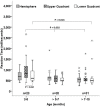Quantification of gaze reaction time in infants with Pediatric Perimeter
- PMID: 34529713
- PMCID: PMC8445470
- DOI: 10.1371/journal.pone.0257459
Quantification of gaze reaction time in infants with Pediatric Perimeter
Abstract
Purpose: We quantified the eye/head (gaze) reaction time in infants to establish a normative database for the Pediatric Perimeter device. Additionally, we tested the hypothesis that gaze reaction time will reduce with age.
Methods: A cross-sectional study was conducted. Healthy infants between 3 to 10 months of age were recruited. Peripheral visual field stimuli (hemifield and quadrant stimuli) were presented in the Pediatric Perimeter device. Infant's gaze to these stimuli was observed, documented in real time, and video recorded for offline analysis.
Results: A total of 121 infants were tested in three age group bins [3-5 months, n = 44; >5-7 months, n = 30 and >7-10 months, n = 47]. Overall, 3-5 months old had longer reaction time when compared to the older infants particularly for stimuli presented in the quadrants (Kruskal-Wallis, p<0.038). A significantly asymmetric difference (p = 0.025) in reaction time was observed between the upper (median = 820ms, IQR = 659-1093ms) and lower quadrants (median = 601ms, IQR = 540-1052ms) only for the 3-5 months old infants.
Conclusion: This study provides the normative gaze reaction time of healthy infants. With increase in age, there is reduction in reaction time and disappearance of reaction time asymmetry in quadrant stimuli. The longer reaction time for upward gaze could be due to delayed maturation of neural mechanisms and/or decreased visual attention.
Conflict of interest statement
The authors have read the journal’s policy and have the following competing interests: SD and PNS have an approved US patent (No.: 10517475 B2) and an India patent application (No.: 4341/ CHE/ 2015) on the Pediatric Perimeter device used in this study. This does not alter our adherence to PLOS ONE policies on sharing data and materials. Enhancement to this device design is still underway. There are no other patents or marketed products associated with this research to declare.
Figures


References
-
- Heidary G (2017) Visual field testing in pediatric patients. Journal of Pediatric Neurology 15: 10.
-
- Canfield RL, Wilken J, Schmerl L, Smith EG (1995) Age-related change and stability of individual differences in infant saccade reaction time. Infant Behavior and Development 18: 351–358.
Publication types
MeSH terms
LinkOut - more resources
Full Text Sources

